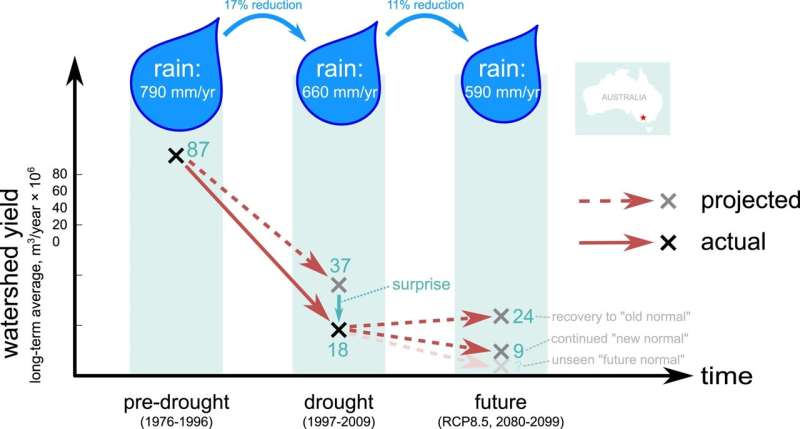Watershed yield history and projections for Australia's Campaspe River (station 406213, basin area 640 km2), which shifted behavior during the Millennium Drought and has not yet recovered. Climate projections are from Clarke et al. (2019) and are based on Conformal Cubic Atmospheric Model (CCAM) Regional Climate Model simulations with MIROC5 as host global climate model. Hydrological projections are from the GR4J hydrological model. MIROC5 is in the middle of the range of projections from Clarke et al. (2019) and GR4J is widely applied in south-east Australia. Credit: Water Resources Research (2022). DOI: 10.1029/2021WR031210
From 1997 to 2010, southeastern Australia experienced its worst drought on record. The "Millennium" drought severely strained municipal and agricultural water supplies—and despite a return to near-predrought rainfall levels, some of the region's watersheds have not yet recovered. The extended dry spell delivered two surprises: streamflows that were surprisingly low during the drought, even considering the low rainfall, and a lack of post-drought recovery in streamflows back to predrought norms.
In recent years, similar hydrological shifts have occurred in watersheds across multiple continents, including in California, Chile, and China. In their study published in Water Resources Research, Fowler et al. address these unexpected shifts and discuss the implications for future water management and hydrological research.
A major concern the researchers discuss is that climate change could trigger similar surprise shifts in many more watersheds, threatening ecosystems and water supplies worldwide. So far, the magnitude of this risk remains unclear, and more research is needed to determine the underlying causes of these reductions in streamflow. However, existing evidence suggests that these causes are not rare, indicating it could be prudent to plan for such shifts even in watersheds that do not yet show concerning signs.
Because the underlying mechanisms are still unclear, existing hydrological models do not adequately predict future hydrological shifts. A key unknown is whether "shifted" watersheds will recover over the span of current planning horizons. The researchers demonstrate that the resulting uncertainty is comparable in magnitude to other uncertainties inherent in the problem of projecting future streamflows—specifically, uncertainty in their response to climate change.
The researchers call for development of new hydrological models that better predict streamflow shifts associated with droughts and that do not require recalibration as the climate changes.
In the meantime, climate change risk assessment methods could be refined to account for the possibility of unexpectedly low streamflow during and after droughts. In addition, planners and policymakers could implement strategies to boost the resilience of water systems.
More information: Keirnan Fowler et al, Hydrological Shifts Threaten Water Resources, Water Resources Research (2022). DOI: 10.1029/2021WR031210
Journal information: Water Resources Research
Provided by Eos
This story is republished courtesy of Eos, hosted by the American Geophysical Union. Read the original story here.
























